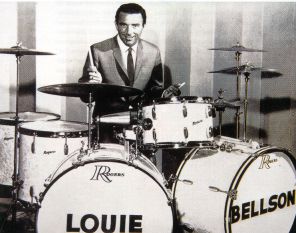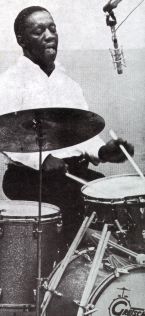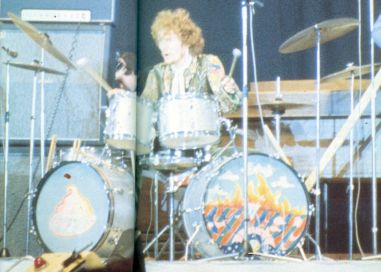
Gene Krupa & a classic Slingerland Kit


The Drum Thing
People who are at the peak of their field have something special usually an intense single mindedness to achieve their personal goal. But in music you have to have something extra - an innate sense of musical form.
Modern drumming is an African American art form developed from African rhythms but including the structural elements of European military bands. It is a creation of the black Jazz drummers spawned from the cultural melting pot of New Orleans. It is also the product of the technological powerhouse of the 20th Century USA. White drummers also played their part - Gene Krupa, in conjunction with Slingerland, developed what is the basis for the modern kit (the technology), Louie Bellson was the key developer of the double kick drum technique and Buddy Rich the master of the military/Jazz precision approach.
|
 |
The masters remain those African-American drummers who were such a major influence on
Ginger Baker: Dixielander's in Baby Dobbs and Alton Red; the beboper's in Max Roach
and Art Blakey and the polyrhythms of Elvin Jones. "Some have compared Ginger to
Krupa, and Ginger admires Louie Bellson,
but his main influences are Baby Dodds, Zutty Singleton, Big Sid Catlett (which is where
he copped that phrase from the second part of the "Toad"
solo, after he introduces us to the individual sound of the bass drums...herewego,
therewego, everywherego, let'sgo)." (Chip Stern)
Ginger Baker grew up in England which has THE history of miltary drumming but an
insignificant one in jazz drumming. The only Jazz drummer worthy of note was his mentor
Phil Seaman, a bebop drummer who incorporated African rhythm patterns. Baker had to
develop in an environment that required the drummer to stick to the arrangement especially
in the derivative world of Trad Jazz*. Baker has that innate sense of rhythm - he always
knows where the one is.
|
 Art Blakey |
Ginger is a "jazzer" but he loved the off beats like Art Blakey. It was an easy move to R&B where loud drumming was acceptable and he brought considerable fundamental musical skills for people who were generally self taught and ear learners. While he could flexibly play the off beats he could also introduce a between-the-beat through the high hat plus the bass drum bombs to goose a boring player. These bands found things filled and emphasised that most pop music drummers couldn't do and most English jazz drummers wouldn't do. Playing with different styles of bands undoubtedly helped: the reverential Blues of the Korner/Davies band, the more free form jazz of the Birch octet, the Ornette Coleman inspired jams with Jack and Dick, the raw R&B with Graham Bond on Hammond. It was the latter that was a band that was as raw and powerful as any R&B band of the US - it was not derivative but a unique amalgamation of genres.
The studio recordings of the Bond band are not in my collection - WHERE'S THE RUMOURED BOX SET!!!!! However I, dunno when, managed to pick up a French cheapo label pressing of the GBO live at Klooks Kleek. An indispensable archive of this seminal band and specially of two rock giants in a formative stage.
The Klooks Kleek recording is fascinating but something less than inspired. It appears it was an attempt at a live recording - a well used function of the venue. Once again a band that relied on spontaneity and the resulting inevitable inconsistency, produced a flat performance because they knew they were being recorded. It is disciplined with Baker and Bruce being a controlled rhythm section backing Bonds organ and raw, very raw, vocals. But there is a clear none blues feel, something is added, something slightly off beat. There is no doubt that Jack Bruce and Ginger Baker have some magical musical link.
The drumming is not what we hear with Cream. It is more controlled, holding the groove but swinging. There is a typical jazz approach of snare/hi-hat/cymbals/bass drum with limited tom work. The kit sound is quite unusual with the toms and bass being deep and resonant. It was his home made kit - perspex shaped over his mother's stove then completed with standard fittings. Jack Bruce: "I have never heard drums sound as good as those home-made ones." The snare was almost certainly his beloved wood 6.5" black finished Leedy Broadway he got from Alton Red, a trad drummer in Kid Ory's band, and he's still plays it. The solo on "Early in the Morning" is very much a jazz style even with the song being built around a triplet tom pattern. His approach to drumming in an R&B context is replete with jazz devices.
The Cream Kit

Cream represented a change in approach for each of the members. For the guitars, gear went from Combos to the Marshall Stacks. Baker had already replaced his hand made kit with a full commercial setup in late '65/early '66 (the story is that Jack Bruce had demolished them with his Double Bass during an onstage brawl). He chose Ludwigs probably because they had the reputation of being a loud kit. Another reason is that they had a similar sound to his unique homemade kit.
The other major change was to a double kit. Dave Clark had been using double top toms for some time and Keith Moon adopted that setup in 1965. Keith added a 2nd bass drum and another top tom (simply by joining two standard kits together) sometime around May/June 1966. Based on this it is unclear who went first as Baker was getting his custom kit assembled in America at this time. Most likely they had both (Baker definitely) seen Sam Woodyard in the Duke Ellington Orchestra and both adopted it around the same time or maybe Ginger did tell Moonie what he was putting it together.
Baker's configuration was in the jazz style: retaining a 20" kick drum and adding a 22" but of unique depth of 11" instead of the standard 14". The accompanying toms were also scaled - 12x8 & 13x9 mounted, 16x16 & 18x16 floor toms of which the latter is an unusual size at this time. The 6 1/2" Leedy wood snare was retained as was his light 13" hi-hat plus a modest array of cymbals ( 22" crash/ride, 18 & 20" crash, with another 20" ride added in '67). By jazz standards this was a massive kit: the great Elvin Jones played a snare, 20" kick, 12x8, 16x16, hi-hat, 22" rivetted crash ride and 20" crash!

Baker's kit was assembled by London's Drum City store with Baker even going to Zildjian's Boston factory to hand select cymbals (probably during the May '67 visits) for his '67 expansion. It was not a pure Ludwig kit as many of the fittings were Rogers for strength. The reinforcement of drum kits for the powerhouse requirements of Rock music was only just beginning. The configuration is significant as it defines one of the directions rock drum kits were to take.
So why such a massive kit considering the enormous variety of sounds and power that someone like Elvin Jones got out of his small kit?
One reason was that it looked impressive!
The other was simply to do with volume. A jazz player can coax a whole variety of subtle tonings out of his kit as the drums were the loudest instrument in the band. Elvin Jones would play all over his crash-ride and get a huge range of sounds and the same with the drums - rim, centre, stick, mallett etc. In the high volume world of Marshall stacks, and no drum miking, such subtlety is drowned. The answer was to have a greater range of drums/cymbals that could produce the variety of sounds simply by hitting them with power strokes. The subtlety of the position of the stroke is replaced by the selection of the appropriate drum/cymbal. Thus the configuration that allowed a tightly tuned scale of notes. The 2nd kick drum wasn't added for speed, it was added for additional bottom end (listen to the ending jam on "White Room" for its use 'par excellance'). Essentially Baker retained a jazzer's approach unlike Keith Moon and latter John Bonham.

* Trad Jazz was a heavily stylised derivative of mid-late 1920's New Orleans jazz.
© Graeme Pattingale, 1999
Updated Jan 28, 2001, © Graeme Pattingale, 2001
Principal Sources: Chip Stern, John Platt, "Disraeli Gears", Chris Welch "Cream: Strange Brew", Chip Stern and various Ginger Baker interviews.